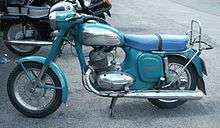František Janeček
| František Janeček | |
|---|---|
.jpg) | |
| Born |
23 January 1878 Klášter nad Dědinou, Kingdom of Bohemia, Austria-Hungary |
| Died |
4 June 1941 (aged 63) Prague, Czechoslovakia |
| Nationality | Czech |
| Occupation | Motorcycle designer and engineer |
František Janeček was the founder of Jawa motorcycles and an important figure in the development of the Czech motorcycle industry. He died on 4 June 1941.[1]
Early life
Janeček was born on 23 January 1878 in Klášter nad Dědinou, a small village in Bohemia in the present-day Czech Republic.[1] He went to Prague to study mechanics at the Prague Technical School and then moved to Germany to the Berlin College of Engineering.[2]
Upon graduation he returned to Prague and began working for the Jewish industrialist Emil Kolben at the Kolben company. He did well and when he was only 23 he was appointed manager of the new factory opened by Kolben in the Netherlands, where he met his future wife. He was hit by a car when riding his bicycle to work. The daughter of the driver gave him first aid, and they became friends and later married.[1]
When Janeček was 31 he opened his own engineering workshops in Prague.[2]
World War I
After serving on the Italian front in World War I Janeček experienced a prolific period of designing and inventing and secured over sixty new patents, including a design for an improved hand grenade[2] The grenade, named Model 21, became the standard hand grenade of the Czechoslovak army, and was nicknamed the "Janeček".[3]
Motorcycle development

Janeček saw an opportunity in 1927 to turn a former armament factory into a motorcycle manufacturing company. He drew on his knowledge of engineering and his experience with factory mass production techniques and based his new motorcycle designs around an existing 498cc engine made by a German company called Wanderer. The new company was named JAWA in 1929, a compound of the first two letters of Janeček and Wanderer.[1]
Janeček first began producing Wanderer motorcycles under license in 1927 in order to diversify the interests of his arms factory. His first motorcycle has a number of advanced features, including shift-drive and a steel frame. He was able to recruit an experienced British motorcycle designer George William Patchett and together they developed a range of competition motorcycles to promote the new Jawa brand.[4] In the 1930s Janeček expanded the range to include lightweight economy models based around British Villiers two-stroke engines, as well as middleweight 350cc side valve and overhead valve motorcycles under the Jawa brand (e.g. Jawa 350).[4]
World War II
When Czechoslovakia was occupied by Nazi Germany in 1938 Janeček was forced to turn his factory over to the occupying command and it was used to produce German aircraft engines and generators.[1] He continued to work in secret on the development of single cylinder two stroke motorcycles and the production was restarted following the end of the war.[4]
František Janeček died on 4 June 1941 and the Jawa company was then taken over by his son Karel Janeček.[1]
Littlejohn adaptor
The Littlejohn adaptor was a device that could be fitted on to the British QF 2 pounder (40 mm) anti-tank gun. It was used to extend the service life of the 2-pounder during World War II by converting it to squeeze bore operation. "Littlejohn" came from the literal anglicization of František Janeček's name.[5]
References
- 1 2 3 4 5 6 "The History of JAWA-CZ...". Westcoast Motorcycles. Retrieved 5 December 2010.
- 1 2 3 "Foundation of JAWA company and JMT alliance". Retrieved 5 December 2010.
- ↑ "Non functioning replica grenades". Retrieved 5 December 2010.
- 1 2 3 "Brief History of the Marque: Jawa". Retrieved 5 December 2010.
- ↑ Williams, Anthony G. "The Littlejohn Adaptor". Retrieved 5 December 2010.